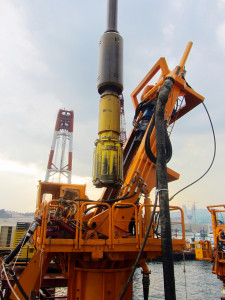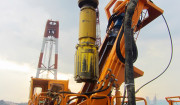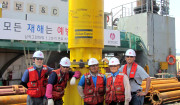The city of Samcheok on the east coast of Korea is renowned for its pristine natural beauty, fresh seafood, crisp coastal breezes and sparkling turquoise waters. Nowadays it can also claim to be the first location in the country to use Atlas Copco?s cluster drill technology.
Engineers currently building a new fuel loading pier was faced with the challenge of drilling of 84 holes, 1?100 mm in diameter, into the sea bed for the installation of piles to support 21 platforms.
 After discovering that the net penetration rate of an Atlas Copco cluster drill was five times faster than conventional drilling methods, international civil engineering company Sambo E&C, decided to become the first company in Korea to put it to the test.
After discovering that the net penetration rate of an Atlas Copco cluster drill was five times faster than conventional drilling methods, international civil engineering company Sambo E&C, decided to become the first company in Korea to put it to the test.
The cluster drill concept, which is based on bringing a number of DTH (down-the-hole) hammers together in one assembly, are produced by Atlas Copco H&F Drilling of Scotland. They are individually designed according to different applications and customer requirements. In this case, Sambo E&C chose a reverse circulation (RC) version equipped with six CS8 (8-inch) hammers.
All of the hammers are fitted with Atlas Copco?s Quick Change Bit System and the four gauge hammers are fitted with special self-indexing bits.
Sambo E&C?s drill rig model STD150 was utilized for the drilling, applying a torque of 12?m per tonne.
The air package consisted of four air compressors including one XHVS 487 set at 16 bar, with the surge line taken from the same supply.
After Sambo E&C?s cluster drill had arrived, John Henderson, consultant for H&F Drilling, traveled to the site to oversee the start-up and initial testing as well as to train the local drilling team. The drill went into full production at the end of August this year. At this point, the casing had been driven to a depth of 25?m and installed 5?m into weathered rock. After product training and construction of the in-hole assembly, the drilling commenced in the broken rock within the casing.
Flushing, a key factor
Although the penetration rate varied from 1.2?m?1.8?m/h during this period, it was clear that the combination of broken ground and poor hole cleaning was causing problems in-hole and that the penetration rates could be improved.
MyungHyun Ko, Sales Engineer at Atlas Copco Korea, says: ?We had several hours of meetings with Sambo E&C to discuss the in-hole problems, DTH reverse circulation methods and the design of set up. It was then, when we had discussed all the other options open to us, that a joint decision was taken to change the flushing method.
?It was no small feat and the team went about the alterations on site with great enthusiasm. It was a real team effort with input from all parties, but even so, the alterations took two days to complete and rebuild the drill string.?
When the drilling got under way again, there was an immediate difference in the efficiency of the flushing and surging (cleaning of the hole). As a result, the drill?s penetration rate improved dramatically to 6?m/h. This equated to 3 m/h drill time due to the time spent surging the hole and lifting it off the bottom to self-rotate the gauge bits in order to ensure a clean hole and optimize the bit life.
Sambo E&C was able to continue drilling and finished the hole to 25 m at the same penetration rates through harder formations with no evident bit wear. All in all, the drill lived up to its reputation, proving to be five times faster than other drills and methods previously used on the site.
Dong-Gil Kim, Project Manager of Sambo E&C, told M&C: ?The penetration rate was incredible. The Atlas Copco cluster drill is innovative and it offers optimal solution for drilling in harder formations.?
John Henderson adds: ?It was a fantastic learning experience for all concerned. This was on site product development, working closely with the customer and we owe a big thanks to Sambo E&C for this interaction and for being so proactive in helping to make the launch of our cluster drill successful in Korea.
?You learn a lot from working with an experienced contractor, and in this instance it certainly proved that you can only drill as fast as you clean the hole.?
It is now expected that Atlas Copco?s cluster drills will become the method of choice for large hole drilling in Korea within a wide range of infrastructure applications such as foundations for bridges, offshore wind turbines, piling, rock sockets, ventilation shafts and slurry walls.
Epiroc operated under the trademark “Atlas Copco” prior to January 1, 2018.




Here:
Us: